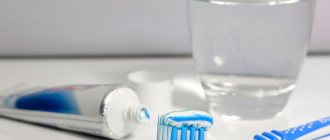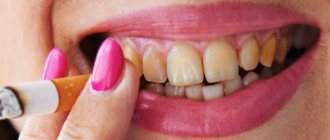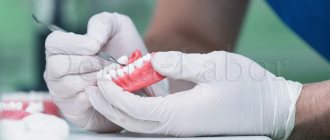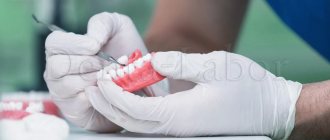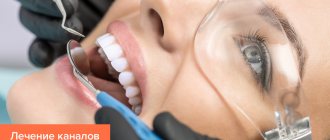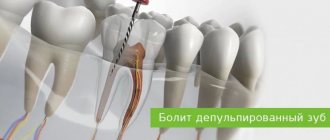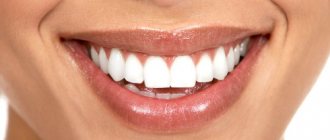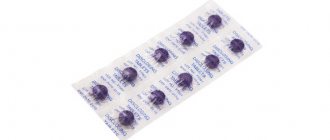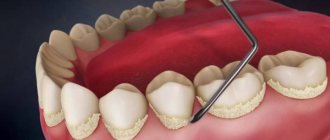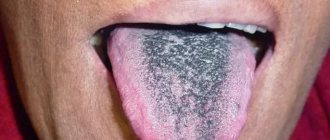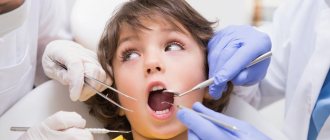One of the most common causes of oral diseases is dental plaque, or rather the bacteria that contribute to its appearance. If soft plaque is not removed in time, it mineralizes, that is, it hardens and turns into tartar. Tartar is the main cause of inflammation and bleeding of the gums, bad breath and the development of periodontitis. To maintain healthy teeth and gums, you can use plaque indicators.
Plaque indicators are special products that paint dental plaque in bright colors, because in the initial stages of plaque formation it is impossible to notice the naked eye.
How do indicators “color” teeth?
All products that are produced abroad today are a mixture of two dyes:
- brilliant blue - used for coloring confectionery products;
- violet - included in lipsticks in rich red shades.
Both dyes are recognized as absolutely safe, as they are added to food all over the world. Therefore, plaque indicators can be used by everyone, regardless of age. This is the main advantage of indicators.
What are plaque indicators used for? If such a composition gets on the teeth, the dye interacts with the resulting plaque and clearly reveals it. Moreover, the blue dye “sticks” better to dense old plaque, which cannot be removed without professional cleaning, while purple dye interacts well with fresh plaque. Therefore, when using plaque indicators, teeth may appear either pinkish or bluish-blue in various shade variations. The only side effect of using these products is that your tongue will turn a deep purple color for up to six hours. However, while for adults this is an embarrassing inconvenience, for children it is a fun highlight that they can show off to their friends.
Composition of the product
The composition of preparations for the determination of dental plaque includes erythrosine, which is a food additive and is designated by the symbol E127. This substance is safe for both adults and children. When reacting with plaque, it produces a shade ranging from bright pink to deep blue.
Most often, manufacturers add flavorings and flavor enhancers to the indicator; sugar or xylitol can also be used. This is done to ensure that the procedure is enjoyable and enjoyable for children and adults.
Types of indicators
There are two types of means for detecting plaque on teeth.
- Pills.
They must be chewed and distributed with the tongue over the surface of the teeth. Plaque is colored in different shades, revealing areas of the teeth that need additional attention. - Solution.
They need to rinse their mouth after brushing or apply it with a brush, then wait a few minutes and evaluate the result of the hygiene procedures. After assessing the result, it is usually enough to re-use the toothbrush and toothpaste. Dyes are easily washed off from teeth along with dangerous plaque residues.
Where to buy plaque detection tablets
Our online store offers a wide range of oral care products. We offer our clients products from reputable manufacturers that are trusted by dentists - CURAPROX, TePe, Miradent, PD, PARO AG, ZANTOMED. The quality of the drugs is confirmed by international certificates.
Delivery throughout Moscow of tablets for detecting dental plaque is free if the order value is over 5,000 rubles. You can fill out an application on our website 24 hours a day.
You can buy PRODUCTS FOR DETECTION OF DENTAL PLAQUE inexpensively and at a favorable price in the online store 'Dental Pharmacy Denteka'. The store presents TOOLS FOR DETECTION OF DENTAL PLAQUE with descriptions, as well as detailed technical specifications, photographs and reviews from visitors. We offer DENTAL PLAQUE DETECTORS from the world's leading brands with a guarantee and delivery.
Plaque indicators for children
It will be quite difficult for kids to get used to the indicator in tablet form, so experts recommend starting with the product in liquid form.
A plaque indicator for a child is a good way to form a healthy habit of brushing teeth correctly from an early age. Using the product usually turns into a game: children like to watch how their white teeth change color, and then “fight” bacteria in those areas that the solution highlights brightly.
Adults in this game play the role of attentive observer. It is necessary to monitor the dosage of the product to ensure that the composition does not get on clothing, as it can stain it. After the “battle” with plaque, the liquid does not need to be swallowed. After cleaning, all stained areas of the teeth should return to their usual color.
Oral hygiene in children
Do you know that children need to perform oral hygiene even before the first tooth erupts?
You might be surprised now. After all, there are no teeth, why brush anything? However, food debris forms a plaque on the mucous membrane - the same as on the teeth, and milk sugars are an excellent breeding ground for bacteria. This leads to stomatitis, painful sores in the mouth and unnecessary frustration for the child and mother.
Therefore, dentists recommend performing hygienic treatment of the oral cavity with a soft silicone fingertip from the first days of life. And during teething, using a silicone massager can gently clean sensitive gums without causing unnecessary trauma to it - and even relieve pain.
Oral hygiene in children
From the moment the first baby tooth appears, it is necessary to purchase the baby his first toothbrush . Dentists of the KANO clinic network recommend children's toothbrushes Curaprox, Montcarotte and others. The selection criterion is that the brush should have a small cleaning head and a large handle, then the child will subsequently be able to get used to brushing his teeth without any problems. First, parents brush the baby's teeth using soft circular movements. Then, when the child grows and gets used to the brush, under the supervision of adults, he begins to try to clean his teeth. It’s great if parents check their child’s teeth brushing and, if necessary, brush their child’s teeth - this can be done at 7 and 10 years old. After all, the main thing is to protect fragile teeth from caries and complications.
Dental treatment for children: examples of work
From 10-12 years of age - when baby teeth are replaced by permanent ones - the child should be able to brush his teeth using an adult method:
- sweeping movements from the gums from the inner and outer surfaces of each tooth (10-15 brush movements for each segment).
- then sweeping movements along the chewing surfaces (10-15 times).
- The cleaning ends with circular movements along the outer surface of the closed teeth - a gentle massage of the gums occurs.
Since children's teeth are small in size, it is convenient to clean them with monotuft brushes ( Curaprox CS 1006 and analogues). How to use these brushes? After standard cleaning, it is recommended to clean each tooth with a mono-beam brush - dry or barely dipping it into the paste.
Brushing teeth with monotuft brushes
Many parents are interested in mechanical toothbrushes. This is an excellent option, but only if the child has already learned to brush his teeth with a regular brush. Giving a child a mechanical one and hoping that it will significantly improve poor hygiene is still quite reckless.
If you decide to purchase a children's mechanical brush, we recommend the Revyline RL 020 Kids sonic toothbrush . It has a low vibration frequency of the bristles, so the gums and fragile enamel are not injured. Revyline RL 020 Kids is equipped with different cleaning modes, and comes with stickers so that your child can decorate his brush.
Brushing children's teeth: sonic toothbrush
Plaque indicators
How to add an element of play to brushing your teeth and at the same time check your child’s hygiene level? There is a great tool called a plaque indicator . This is a solution or tablets for chewing, which contain only food coloring - which means the product is absolutely harmless. In a matter of seconds after application, the indicator will color the entire plaque on the teeth pink-violet. And the most interesting thing is that this staining can be removed only by mechanical cleaning. That is, the child will be able to see with his own eyes the harmful plaque and how brushing teeth effectively helps get rid of it.
What do teeth stained with an indicator look like?
If possible, dentists recommend that children under 10 years of age brush their teeth after every meal - with a brush and a minimum amount of toothpaste. However, we understand that brushing your teeth after eating is not always possible. When you don’t have a brush and paste at hand, foam can handle oral hygiene - for example, Splat Junior . It is distinguished by its “pure” composition, which includes enzymes, calcium and plant extracts. Once applied to the teeth, a cloud of foam regulates the formation of plaque and restores the acid balance.
Oral foam (for children)
Fluoride is very important for teething and just emerging teeth. Numerous scientific studies have proven that fluoride strengthens teeth and should be used in toothpaste – especially for children! The territory of the Republic of Belarus is endemic in fluoride, that is, we all have a fluorine deficiency - which means it is almost impossible to get too much fluoride from toothpaste.
Therefore, for Belarusian children under 6 years of age, the amount of fluoride in the paste should be at least 1000 ppm, and after that the adult dosage should be 1500 ppm. An example of an excellent children's toothpaste with fluoride is Apadent Kids.
How much toothpaste does a child need?
The European Association of Pediatric Dentists (EAPD) recommends the following proportions according to the age of the child:
- up to 2 years – traces of paste (that is, just dip the brush into the paste), sometimes they say – the size of a grain of rice (0.125 g),
- 2-6 years – about the size of a pea (0.25 g),
- after 6 years – on the entire surface of the brush (0.5-1g).
Children's toothpaste with fluoride
What about dental floss ? Floss must be connected already at the stage of eruption of baby lateral teeth (1-1.5 years). And at the age of 6-9 years, when the distance between the teeth rapidly decreases, the usual slits close and crowding of the teeth may even appear - there is no way to cope without floss. Superfloss is perfect for children's hygiene - it is super soft and does not injure delicate gums.
If you are used to mouth rinses and would like to teach your child to use them, you can choose Elmex Junior . It does not contain alcohol or antiseptics, but does include a small amount of fluoride (250 ppm). This mouthwash can also be used safely by preschoolers.
Children's mouth rinse
An additional means of strengthening tooth enamel are Tooth Mousse and ROCS Medical Minerals . Pediatric dentists recommend using them as permanent teeth appear, because the tooth erupts immature and is gradually saturated with calcium, phosphorus and other elements. And with the help of mineralizing gels, you can help strengthen and protect the enamel, especially if your child is prone to caries and has a lot of fillings. Tooth Mousse and ROCS Medical Minerals gels have no age restrictions and are safe to swallow.
Helper apps
In the digital 21st century, our entire lives are based on smartphones. Today you can even install a free application for brushing children’s teeth on them - for example, Mimizaurus brushes teeth . You turn on one of the proposed 28 videos for your child, and while watching the screen, your child learns how to brush his teeth while listening to cheerful music, in a playful way and without boredom. At the end, the child receives a small virtual bonus, which motivates him not to miss the next cleaning.
Another app is Chomper Chums . The kid chooses an animal (lion, crocodile or horse) and, depending on the diligence and time of brushing his teeth, earns coins in the application to feed the little animal with tasty and healthy food. And if you brush your teeth regularly, you can send your animal on a journey through virtual worlds.
Another option : you can make a poster and put stickers (for example, stars) on it after each cleaning. And at the end of the month, give the diligent child a gift.
Teeth brushing app
What is xylitol?
One promising agent for preventing tooth decay is xylitol, a natural sugar substitute. It is used in the production of healthy chewing gums, candies and lozenges for children (such as Xylitol drops and Xylitol Chewing Gum ).
The mechanism of action of xylitol is based on the fact that microorganisms living in the oral cavity are accustomed to feeding on sugars from our food. But when bacteria eat xylitol, mistaking it for sugar, they cannot grow and multiply further. Therefore, the number of microorganisms that cause caries decreases, and less plaque forms on the teeth.
What is xylitol?
However, you should not get carried away with sweets with xylitol: it is optimal to eat 3-5 pieces a day, this corresponds to approximately 5 g of xylitol.
A very convenient form of using products with xylitol is napkins for wiping teeth. They can be used after meals even by an infant. For example, Brush-Baby or Asepta : they have a fingertip shape, which makes them easier to use. And the slight cooling effect of these wipes reduces discomfort during teething.
An example of a toothpaste with xylitol is Neobio Kids . Due to its good composition and the absence of fluoride, it is optimal for children under one year old.
Caring for children's teeth
It is important for fathers and mothers to understand: the health of teeth throughout life depends on how children’s teeth are cared for in the first years of life. With their care and attention, parents are able to lay a strong foundation for their child’s dental health and help him avoid treatment for caries, gum disease, and even implantation.
Which indicator should you choose?
Manufacturers of the most famous indicators at the moment, in the line of which you can find both liquid products and indicators in tablet form:
- Miradent;
- Curaprox.
The production volume can be different, so it’s easy to choose the one that’s right for you: a package of tablets can contain from 6 to 250 pieces. A bottle of liquid - from 10 to 500 milliliters.
Some manufacturers provide a separate line of products for children, adding flavors to the solution, for example, chewing gum, which kids like.
The best manufacturers
Which company is better to choose a product? There is a wide variety of these manufacturers on the dental product market. The demand for the product largely depends on the manufacturer. The most popular well-known brands, according to customer reviews:
- Curaprox. This Swiss manufacturer produces oral care products. All products are developed taking into account new technologies and are popular among the population.
- StomaDent. This Russian manufacturer has been on the goods market since 1989. Produces quality products. In its arsenal it has dental products for various purposes.
- PresiDENT. The Italian manufacturer launched the company in 1999. A wide range of products are produced according to the ISO International Quality System. This process is led by Italian technologists and dentists.
- Modum Wünderdent. The famous Belarusian, together with the German company Weisskoss GmbH, created the products of this brand. Although it is considered a young competitor in the dental market, it is not inferior in quality to its rivals.
- Miradent. The German manufacturer was founded in 1982 and is a subsidiary brand of Hager&Werken. Engaged in the development of highly effective dental products that meet all norms and standards. The products are manufactured by world-class dentists and leading pharmacists.
- Paro. This Swiss manufacturer has been operating in the dental market since 1978. They produce products that prevent gum and tooth disease. The company has developed and tested all its products using the latest technologies.
What to pay attention to
- The plaque indicator may contain xylitol or saccharin to give the solution a pleasant taste, although the product may be completely tasteless.
- Preference should be given to indicators with dyes that act only on the surface of the teeth and do not affect the mucous membrane.
- It is best to avoid solutions or tablets containing gluten or erythrosine due to the body's sensitivity to these substances.
One of the important rules of oral hygiene is thorough removal of plaque from the surface of the teeth and tongue. Don't forget that plaque often causes dental diseases. Use the plaque indicator in the form you prefer. It's effective, safe and very simple.
How is plaque formed?
Already 20 minutes after eating, the tooth is covered with a film invisible to the eye - pellicle - this is a kind of matrix for the further formation of plaque and tartar. Microorganisms attach to it and begin to actively multiply, releasing acids that destroy the surface of the enamel and provoke the development of caries.
IMPORTANT!
You should visit your dental hygienist once or twice a year for a professional cleaning. However, to maintain healthy teeth, you need to take care of them at home.
Today, you have a huge range of oral hygiene products in your arsenal: these are various manual and electric toothbrushes, therapeutic and prophylactic pastes, dental floss and brushes, irrigators and all kinds of rinses. All this is aimed at improving the quality of your daily cleaning.
Should you use teeth whitening strips? Dentist's opinion
But are these products safe for home whitening? Let’s find out with Vladimir Losev, a specialist at the MEGAST dental clinic, Candidate of Medical Sciences. A snow-white smile is the dream of absolutely most people. In addition, due to certain habits, for example, smoking or consuming drinks such as coffee and strong black tea, plaque can actually form on the teeth, which is difficult to get rid of with regular toothpaste.
Whitening strips help lighten teeth and eliminate age spots on them. They are relatively safe when used correctly, although they are not suitable for all patients. For those who already have problems with enamel, for example, there is increased sensitivity of teeth, it is better to avoid home whitening, including with strips, so as not to make your problem even more noticeable and not create the ground for the appearance of caries.
Ideally, you should consult a dentist or hygienist before attempting home whitening. He can recommend a truly safe brand of at-home whitening strips and confirm that this procedure is necessary for you. Often, doctors themselves suggest completing the in-office whitening procedure at home in order to achieve truly excellent whitening results.
Independent selection of teeth whitening products is fraught with some difficulties, since the dental market today is flooded with low-quality and generally controversial Chinese-made products, so there is a risk, using such products that have not passed certification, of causing irreparable harm to tooth enamel or gum health . In this regard, you need to be extremely careful and purchase products either at the pharmacy or in consultation with a specialist.
It is also necessary to remember that teeth whitening products are not as safe as we think at first glance. As a rule, they contain substances that help lighten the enamel: such as urea and hydrogen peroxide. Often, in-office bleaching uses the same substances. But during in-office bleaching, a specialist controls the process so as not to harm the patient. During the home procedure, patients, obsessed with getting a snow-white smile in the shortest possible time, often violate the algorithm and increase the time.
Strips can be used no more than 2 times a day with breaks of 12 hours. In whitening packages you can find a special gel, which is used to lighten the enamel, and strips of two sizes for the upper and lower jaws, respectively.
Before the whitening procedure, you need to rinse your mouth with water, blot your teeth from excess moisture, apply the whitening gel to the strips and apply them to your teeth for 5-30 minutes. The procedure is best done in front of a mirror to better control the process and avoid accidentally sticking the whitening strips to your gums.
It is necessary to strictly maintain the time - no more than 30 minutes, so as not to harm the enamel. After the procedure, you must carefully brush your teeth and rinse your mouth with water.
As a rule, the results of home whitening become obvious after 2-4 weeks of using the strips. At the same time, while you are doing home whitening, it is recommended to temporarily exclude drinks that can affect the color of the enamel (wine, coffee, strong black tea, etc.) and reduce smoking. Immediately after the whitening procedure, smoking is generally not recommended.
Source: epochtimes.r
